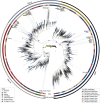Phylogenomics Unveils the Complex Evolution of Retroviruses in Birds
- PMID: 40635662
- PMCID: PMC12287698
- DOI: 10.1093/molbev/msaf171
Phylogenomics Unveils the Complex Evolution of Retroviruses in Birds
Abstract
The rise of birds represents one of the major evolutionary transitions in the history of life. Yet, much remains obscure about the origins and diversification of viruses in birds. Endogenous retroviruses (ERVs), relics of past retroviral infections, provide molecular fossils for interrogating the evolution and ecology of retroviruses. Here, we perform phylogenomic mining of ERVs within the genomes of 758 bird species and identify more than 470,000 ERVs, revealing a highly diverse and complex retrovirus repertoire in birds. These ERVs greatly expand the diversity of retroviruses in birds, indicating that exogenous retroviruses characterized in birds to date are highly underestimated. The evolution of retroviruses in birds is shaped by both coevolution and cross-species transmission. Tens of retrovirus lineages originated during the early evolution of birds, four of which contribute to more than 90% of complete ERVs in birds. We also observe recent ERV activity across the bird phylogeny (particularly in Passeriformes). Moreover, we find that ERVs can mediate genome rearrangements, potentially facilitating the genome evolution of birds. Many bird retroviruses recruited genes of cellular provenience, which might drive the evolution of the genome complexity of retroviruses. Together, these results unveil a diverse and complex retrovirosphere in birds and provide insights into the intricate evolution of retrovirus-bird interaction.
Keywords: birds; endogenous retroviruses; phylogenetics; virus evolution.
© The Author(s) 2025. Published by Oxford University Press on behalf of Society for Molecular Biology and Evolution.
Figures






References
MeSH terms
Grants and funding
LinkOut - more resources
Full Text Sources
Miscellaneous

